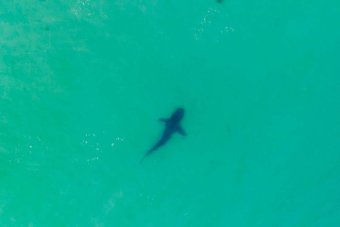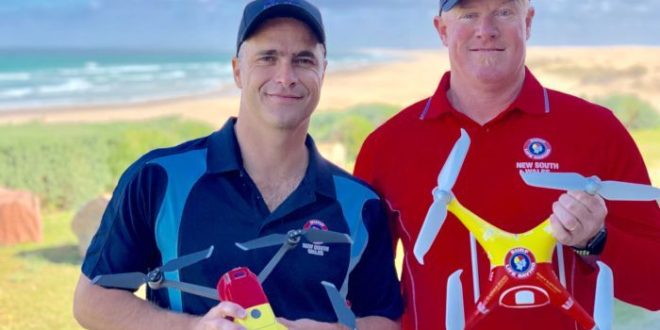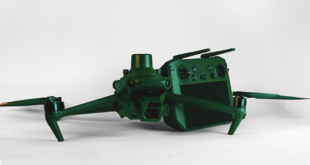Updated
Photo:
Surf Life Saving NSW drone program’s Tom Caska and lifeguard Brad Fox piloted drones. (ABC Newcastle: Ben Millington)
Data from a Surf Life Saving New South Wales (SLSNSW) drone trial has revealed January to be the most significant month for shark activity and the north coast to be the state’s shark hotspot.
Key points:
- 350 volunteers trained as drone pilots for the trial
- 370 sharks were spotted during summer, with 42 per cent of sightings made in January
- Surf Life Saving Australia is also trialling a flotation drop device to assist in rescues from the air and thermal cameras to track crocs and find missing people
It was the largest drone operation ever conducted in Australia with more than 8,000 flights at 20 trial locations along the NSW coast.
The data reveals a total of 370 sharks were spotted during summer and Evans Head had the most sightings with 58.
Byron Bay and Ballina also had a significant number of sightings, as did Pambula Beach on the south coast.
Forty-two per cent of sightings were made in January, followed by April (21 per cent), March (15 per cent) and February (8 per cent).
The collaborative research project was funded by the NSW Department of Primary Industries and Fisheries.
“The data is extremely valuable, it’s one of the largest marine data sets in the world captured via drones,” said SLSNSW drone coordinator Tom Caska.
Drone can warn swimmers
Mr Caska said recorded drone footage from Birubi Beach in Port Stephens shows a 3.5-metre bull shark swimming close to people between the flags before an alarm sounded to alert swimmers.
“If lifeguards spot what they believe to be a shark then they try and identify it as a threatening species — so anything over two metres and a bull shark or a tiger shark or a white pointer,” he said.

Photo:
Shark sightings from drones resulted in 50 beach closures in NSW last summer including this shark spotted at Birubi Beach, Port Stephens. (Supplied: Surf Life Saving NSW)
“If it’s within 200 metres of swimmers then they sound the alarm on the drone itself, and this alerts people who might be in the vicinity to get out of the way.
“Most of the time the sharks may not pose that much of a threat but occasionally they do. So it is a fantastic way to maintain safety at our beaches.”
Mr Caska said NSW beaches were closed 50 times over the summer following a drone shark sighting.
Rescue eye in the sky
Mr Caska said the drones were also very useful in assisting lifeguards in numerous rescues throughout the summer.
Volunteer lifeguard Brad Fox was one of the 350 volunteers trained as drone pilots for the trial.
He said the drones were helped lifeguards assess beach safety.
“In a rescue situation we’re able to fly the drone straight to where we need to be and give [rescuers] a lot of feedback about the scenario that is unfolding there, or how to best approach it,” Mr Fox said.
“What you can see from the air is much greater than what they can see at water level.
“It also helps us spot rips when we’re setting up the beach, so it helps us figure out where we’re going to set up the flags on the day.
“It really expands the toolkit from a lifesaving point of view and it enables us to pinpoint where a problem is.”
Surf Life Saving Australia (SLSA) said it was looking to expand the drone program to more beaches in NSW and around the country next summer.
Thermal cameras and flotation drops
The organisation is also trialling a flotation drop device to assist in rescues from the air.
“We’re still refining it, it’s really exciting,” Mr Caska said.
“It’s basically quite a small lightweight flotation drop device that you can attach to the drone and it gets dropped from altitude and automatically inflates when it hits the water.
“A year ago we had a really good outcome when we used this technology, when we rescued a couple of swimmers.
“We really hope to do the same thing as the technology improves and we train our members to use the new technology.”
Mr Caska said lightweight drones with mounted thermal cameras were also being trialled and could help to pick up the heat signature of someone lost in rough seas or at night.
The drones were also being trialled at numerous locations in the Northern Territory to see if they will help detect heat signatures from predators such as crocodiles.
“As a volunteer organisation we’ve even been able to get more and more people involved,” Mr Caska said.
“They’ve been attracted to coming to work with Surf Life Saving because they’re excited about these new innovative pieces of technology.
“This program is really the future of aerial surveillance.”
Results of SLSNSW drone trial 2018-19
| Location | Shark sightings |
|---|---|
| Cudgen Beach, Kingscliff | 12 |
| Byron Bay | 49 |
| The Pass, Byron Bay | 46 |
| Suffolk Pass | 8 |
| Lennox Head | 19 |
| Sharpes Beach, Ballina | 41 |
| Shelly Beach, Ballina | 25 |
| Lighthouse Beach, Ballina | 35 |
| Evans Head | 58 |
| Yamba | 3 |
| Coffs Coast | 2 |
| Tacking Point, Port Macquarie | 8 |
| Birubi Beach, Anna Bay | 9 |
| Redhead | 1 |
| Avoca | 3 |
| Kiama | 10 |
| Mollymook | 4 |
| Tathra | 0 |
| Pambula | 37 |
| TOTAL | 370 |
Topics:
animal-science,
academic-research,
surfing,
shark,
surf-life-saving,
marine-biology,
safety,
travel-health-and-safety,
environmental-technology,
nelson-bay-2315,
tathra-2550,
mollymook-2539,
kiama-2533,
avoca-beach-2251,
redhead-2290,
coffs-harbour-2450,
yamba-2464,
shelly-beach-2261,
lennox-head-2478,
suffolk-park-2481,
cudgen-2487,
byron-bay-2481,
evans-head-2473,
pambula-2549,
ballina-2478
First posted
 Unmanned Aerial Vehicle The latest drone news
Unmanned Aerial Vehicle The latest drone news




